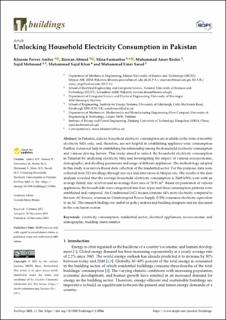| dc.contributor.author | Amber, Khuram Pervez | |
| dc.contributor.author | Ahmad, Rizwan | |
| dc.contributor.author | Farmanbar, Mina | |
| dc.contributor.author | Bashir, Muhammad Anser | |
| dc.contributor.author | Mehmood, Sajid | |
| dc.contributor.author | Khan, Muhammad Sajid | |
| dc.contributor.author | Saeed, Muhammad Umer | |
| dc.coverage.spatial | Pakistan | en_US |
| dc.date.accessioned | 2021-12-03T13:12:54Z | |
| dc.date.available | 2021-12-03T13:12:54Z | |
| dc.date.created | 2021-12-01T13:18:56Z | |
| dc.date.issued | 2021-11 | |
| dc.identifier.citation | Amber, K.P., Ahmad, R., Farmanbar, M. et al. (2021) Unlocking Household Electricity Consumption in Pakistan. Buildings, 11(11), 566 | en_US |
| dc.identifier.issn | 2075-5309 | |
| dc.identifier.uri | https://hdl.handle.net/11250/2832785 | |
| dc.description.abstract | In Pakistan, data for household electricity consumption are available in the form of monthly electricity bills only, and, therefore, are not helpful in establishing appliance-wise consumption. Further, it does not help in establishing the relationship among the household electricity consumption and various driving factors. This study aimed to unlock the household electricity consumption in Pakistan by analyzing electricity bills and investigating the impact of various socioeconomic, demographic, and dwelling parameters and usage of different appliances. The methodology adopted in this study was survey-based data collection of the residential sector. For this purpose, data were collected from 523 dwellings through surveys and interviews in Mirpur city. The results of the data analysis revealed that the average household electricity consumption is 2469 kWh/year with an average family size of seven and an average floor area of 78.91 m2. Based on possession of various appliances, the households were categorized into four types and their consumption patterns were established and compared. Air Conditioned (AC) houses consume 44% more electricity compared to the non-AC houses, whereas an Uninterrupted Power Supply (UPS) consumes electricity equivalent to an AC. The research findings are useful for policy makers and building designers and are discussed in the conclusion section. | en_US |
| dc.language.iso | eng | en_US |
| dc.publisher | MDPI | en_US |
| dc.rights | Navngivelse 4.0 Internasjonal | * |
| dc.rights.uri | http://creativecommons.org/licenses/by/4.0/deed.no | * |
| dc.subject | energiforbruk | en_US |
| dc.subject | strømforbruk | en_US |
| dc.subject | strømpriser | en_US |
| dc.title | Unlocking Household Electricity Consumption in Pakistan | en_US |
| dc.type | Peer reviewed | en_US |
| dc.type | Journal article | en_US |
| dc.description.version | publishedVersion | en_US |
| dc.rights.holder | © 2021 by the authors | en_US |
| dc.subject.nsi | VDP::Teknologi: 500 | en_US |
| dc.source.volume | 11 | en_US |
| dc.source.journal | Buildings | en_US |
| dc.source.issue | 11 | en_US |
| dc.identifier.doi | 10.3390/buildings11110566 | |
| dc.identifier.cristin | 1962652 | |
| dc.source.articlenumber | 566 | en_US |
| cristin.ispublished | true | |
| cristin.fulltext | original | |
| cristin.qualitycode | 1 | |

